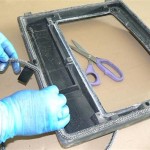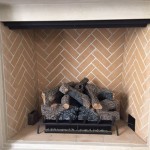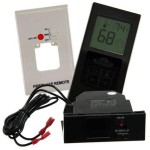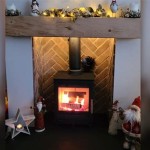How To Decorate Your Fireplace Hearth
The fireplace hearth, the area directly in front of the fireplace opening, is a central visual element of the room. Its decoration provides an opportunity to enhance the overall aesthetic and create a welcoming and comfortable atmosphere. A well-decorated hearth can transform a simple fireplace into a focal point, reflecting individual style and contributing to the room's ambiance. Careful consideration of materials, scale, and arrangement are essential to achieving a balanced and harmonious design.
The hearth serves not only as a decorative area but also as a functional zone. It provides a safe distance from the fire and can be used to store essential fireplace tools and accessories. The selection of decorative elements must account for both aesthetics and practicality, ensuring the space remains both beautiful and functional. Elements should be heat-resistant and arranged in a manner that does not obstruct the safe operation of the fireplace.
Before beginning any decoration, assess the existing style of the fireplace and the surrounding room. Consider the architectural details, the color palette, and the overall design theme. This initial assessment will guide the selection of appropriate decorative elements and ensure a cohesive and harmonious look.
Choosing the Right Materials and Textures
The choice of materials and textures plays a crucial role in achieving the desired look for the fireplace hearth. Different materials evoke different feelings and contribute to the overall aesthetic of the space. Consider the existing materials of the fireplace surround and mantel, and select complementary materials for the hearth decoration.
Natural stone, such as river rocks or slate, provides a rustic and earthy feel. It works well in traditional or country-style homes. The varied textures and colors of natural stone add depth and visual interest. Consider arranging stones of different sizes and shapes to create a natural and organic look. Ensure the stones are securely placed to prevent them from shifting or falling.
Metal accents, such as wrought iron or brass, add a touch of elegance and sophistication. They can be incorporated through candlesticks, decorative sculptures, or even metal fireplace screens. The reflective qualities of metal enhance the light in the room and create a sense of warmth. Choose metal finishes that complement the other hardware and fixtures in the room.
Wood elements, such as logs or wooden crates, contribute to a cozy and inviting atmosphere. They are particularly well-suited for creating a rustic or farmhouse-style hearth. Logs can be stacked neatly or arranged in a more casual manner. Wooden crates can be used to store firewood or other decorative items. Ensure the wood is properly seasoned to prevent excessive smoking when burned.
Textiles, such as rugs or blankets, add softness and warmth to the hearth. They can be used to define the space and create a comfortable seating area. Choose textiles that are durable and easy to clean, as the hearth is prone to dust and spills. Consider using fire-resistant materials to enhance safety.
Ceramic tiles and pottery offer a wide range of colors, patterns, and textures. They can be used to create a vibrant and personalized hearth. Consider using tiles with geometric patterns or floral designs to add visual interest. Pottery can be used to display plants or other decorative items. Ensure the tiles are securely installed and the pottery is made of a heat-resistant material.
Arranging Decorative Elements for Visual Balance
The arrangement of decorative elements is crucial for achieving a visually balanced and harmonious hearth. Consider the principles of design, such as symmetry, asymmetry, and the rule of thirds, to create a pleasing composition. The arrangement should complement the overall style of the fireplace and the surrounding room.
Symmetry creates a sense of order and formality. It involves arranging identical or similar elements on either side of a central point. This approach is well-suited for traditional or formal settings. Consider placing matching candlesticks or vases on either side of the fireplace opening. Ensure the elements are of equal size and weight to maintain balance.
Asymmetry, on the other hand, creates a more relaxed and informal feel. It involves arranging different elements on either side of a central point, but in a way that still maintains balance. This approach is well-suited for modern or eclectic settings. Consider placing a tall plant on one side of the fireplace and a collection of smaller objects on the other side. Vary the heights and textures of the elements to create visual interest.
The rule of thirds is a guideline that suggests dividing the space into nine equal parts using two horizontal and two vertical lines. Placing key elements along these lines or at their intersections creates a more dynamic and engaging composition. Consider placing a focal point, such as a large vase or a piece of artwork, at one of these intersections.
Varying the heights of the decorative elements adds depth and visual interest. Avoid placing all the elements at the same height, as this can create a flat and uninteresting look. Consider using pedestals or stacked books to elevate certain objects. Ensure the heights of the elements are proportionate to the size of the hearth and the fireplace.
Creating layers adds dimension and texture to the hearth. Layering involves placing elements in front of and behind each other to create a sense of depth. Consider placing a rug in front of the fireplace, and then layering decorative objects on top of the rug. Vary the textures and colors of the layers to create visual interest.
Negative space, the empty space around and between the decorative elements, is just as important as the elements themselves. Too much clutter can overwhelm the space and create a sense of chaos. Allow for enough negative space to allow the eye to rest and appreciate the individual elements. A strategically placed empty space can draw attention to a specific focal point.
Incorporating Seasonal and Personal Touches
The fireplace hearth provides an ideal space to incorporate seasonal decorations and personal touches. These additions can reflect individual style and create a welcoming and festive atmosphere. Consider the changing seasons and holidays, and select decorations that complement the current time of year.
In the fall, consider incorporating natural elements such as pumpkins, gourds, and colorful leaves. These seasonal items add warmth and texture to the hearth. Arrange pumpkins of different sizes and shapes to create a visually appealing display. Scatter leaves around the base of the fireplace to evoke the feeling of autumn.
During the winter holidays, consider adding traditional decorations such as garlands, wreaths, and candles. These festive items create a warm and inviting atmosphere. Drape a garland across the mantelpiece and hang a wreath above the fireplace. Place candles of varying heights and sizes on the hearth to add a touch of sparkle.
In the spring, consider incorporating fresh flowers and plants. These seasonal additions bring life and color to the hearth. Arrange flowers in vases or pots, and place them on the hearth. Consider using plants with trailing vines to add a touch of elegance.
During the summer, consider incorporating beach-themed decorations such as seashells, starfish, and driftwood. These seasonal items evoke the feeling of relaxation and vacation. Arrange seashells in bowls or vases, and place them on the hearth. Display driftwood sculptures to add a touch of rustic charm.
Personal touches, such as family photos, artwork, and souvenirs, add character and individuality to the hearth. These items reflect individual interests and create a space that feels personal and inviting. Frame family photos and display them on the mantelpiece. Hang artwork above the fireplace to add a touch of sophistication. Display souvenirs from travels to evoke fond memories.
Change the decorations periodically to keep the hearth looking fresh and interesting. Rotate seasonal items and personal touches to create a new look each time. This will prevent the hearth from becoming stagnant and will keep it looking its best.
Ultimately, the best way to decorate the fireplace hearth is to experiment and find what works best for individual style and preferences. Do not be afraid to try new things and express creativity. With careful planning and attention to detail, the fireplace hearth can become a beautiful and inviting focal point of the room.

How To Decorate A Hearth Bhglivebetter Homedecor Homedecorideas Fireplace Decor Mantle
:max_bytes(150000):strip_icc()/create-a-cozy-fall-fireplace-6a890e0a75a94779be2e6d4ef4784f93.jpg?strip=all)
43 Cozy Ideas For Fireplace Mantels

10 Fireplace Mantel Decorating Ideas Full Service Chimney
:max_bytes(150000):strip_icc()/cozy-fall-mantel-decorating-5dfcd9f83cbc45c9ab67357fe2b52b40.jpeg?strip=all)
28 Fall Mantel Decorating Ideas To Make Your Hearth More Homey

My Fall Mantel Decor With Joann Bless This Nest

How To Decorate A Mantel Like Pro Easy Styling Tips From Tidbits Twine Home Decor Fireplace Mantle

Fireplace Decor Hearth Design Tips

My Spring Fireplace Mantel And Hearth Worthing Court Diy Home Decor Made Easy

Fall Decor Design Ideas Fireplace Mantel Greenhouse Studio

Chic On A Shoestring Decorating How To Decorate Fireplace Simple Tips








